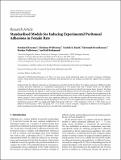| dc.contributor.author | Kraemer, Bernhard | en_US |
| dc.contributor.author | Wallwiener, Christian | en_US |
| dc.contributor.author | Rajab, Taufiek K. | en_US |
| dc.contributor.author | Brochhausen, Christoph | en_US |
| dc.contributor.author | Wallwiener, Markus | en_US |
| dc.contributor.author | Rothmund, Ralf | en_US |
| dc.date.accessioned | 2014-07-07T18:14:57Z | |
| dc.date.issued | 2014 | en_US |
| dc.identifier.citation | Kraemer, Bernhard, Christian Wallwiener, Taufiek K. Rajab, Christoph Brochhausen, Markus Wallwiener, and Ralf Rothmund. 2014. “Standardised Models for Inducing Experimental Peritoneal Adhesions in Female Rats.” BioMed Research International 2014 (1): 435056. doi:10.1155/2014/435056. http://dx.doi.org/10.1155/2014/435056. | en |
| dc.identifier.issn | 2314-6133 | en |
| dc.identifier.uri | http://nrs.harvard.edu/urn-3:HUL.InstRepos:12407014 | |
| dc.description.abstract | Animal models for adhesion induction are heterogeneous and often poorly described. We compare and discuss different models to induce peritoneal adhesions in a randomized, experimental in vivo animal study with 72 female Wistar rats. Six different standardized techniques for peritoneal trauma were used: brushing of peritoneal sidewall and uterine horns (group 1), brushing of parietal peritoneum only (group 2), sharp excision of parietal peritoneum closed with interrupted sutures (group 3), ischemic buttons by grasping the parietal peritoneum and ligating the base with Vicryl suture (group 4), bipolar electrocoagulation of the peritoneum (group 5), and traumatisation by electrocoagulation followed by closure of the resulting peritoneal defect using Vicryl sutures (group 6). Upon second look, there were significant differences in the adhesion incidence between the groups (P < 0.01). Analysis of the fraction of adhesions showed that groups 2 (0%) and 5 (4%) were significantly less than the other groups (P < 0.01). Furthermore, group 6 (69%) was significantly higher than group 1 (48%) (P < 0.05) and group 4 (47%) (P < 0.05). There was no difference between group 3 (60%) and group 6 (P = 0.2). From a clinical viewpoint, comparison of different electrocoagulation modes and pharmaceutical adhesion barriers is possible with standardised models. | en |
| dc.language.iso | en_US | en |
| dc.publisher | Hindawi Publishing Corporation | en |
| dc.relation.isversionof | doi:10.1155/2014/435056 | en |
| dc.relation.hasversion | http://www.ncbi.nlm.nih.gov/pmc/articles/PMC3997962/pdf/ | en |
| dash.license | LAA | en_US |
| dc.title | Standardised Models for Inducing Experimental Peritoneal Adhesions in Female Rats | en |
| dc.type | Journal Article | en_US |
| dc.description.version | Version of Record | en |
| dc.relation.journal | BioMed Research International | en |
| dash.depositing.author | Rajab, Taufiek K. | en_US |
| dc.date.available | 2014-07-07T18:14:57Z | |
| dc.identifier.doi | 10.1155/2014/435056 | * |
| dash.authorsordered | false | |
| dash.contributor.affiliated | Rajab, Taufiek | |


